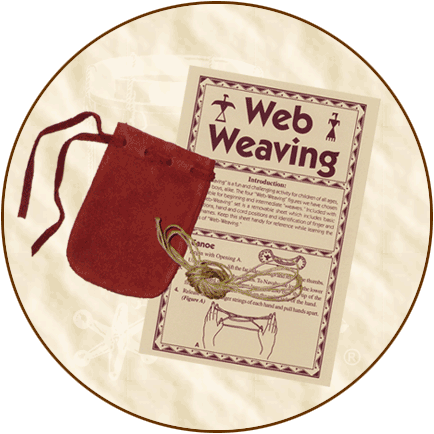.
Continued from product description on
Native American's Page Three...
Historical
Background: Web weaving, or using the hands to make "string
figures" with a loop of cord, predates recorded history.
Because of this, the origin of string figures is unknown. Evidence
of string figures can be found in nearly all native cultures
of the Americas (North, Central, and South), East Asia, Africa,
Australia, the Arctic region, and the Pacific Islands. Prehistoric
drawings suggest string figures have been made since Man learned
to tie the ends of a string!
The purpose of making string figures varied from place to
place. Sometimes string figures were made just for fun while
also proving an artistic outlet. One can easily imagine the need
to relax and entertain after a day of dangerous hunting and tedious
gathering. In many native cultures, string figures were used
by tribal storytellers to illustrate their tales. Other cultures
created string figures to serve as good luck charms. These "string
charms" were used to ward off bad spirits, ask the spirits
for a bountiful harvest, or guarantee a successful hunting expedition.
String figures were also used to teach tribal traditions and
practices. Storytellers around the world used string figures
to teach lessons through their stories of spirits, people, animals,
and places. String figures, stories and chants were used together
to teach, worship, and entertain. In teaching, string figures
may very well have been the world's first visual aid -- thousands
of years before clay tablets and chalkboards!
The number of possible string figures is theoretically limitless.
Loops can be small or large. The larger the string loop, the
more types of string figures can be made. Larger loops also allowed
two or more sets of hands to create complex figures and share
the fun! (Who knows? String figures may have been our earliest
form of group participation games!) Since the time when anthropologist
Franz Boas first described how to make an Eskimo string figure
in 1888, instructions have been written for over 2,000 traditional
patterns! Of course, this does not include all the patterns that
have been forgotten over the millennia.
Fun
Fact: In Hawaii, the art of string figures is called Hei
(a snare, stratagem, or ruse; to ensnare, entangle, or catch
in a net).
Fun
Fact: The Navaho used string figures to teach about the
stars. Many string figure patterns relate to the sun, moon, and
stars. Perhaps this is partly because string figures have been
used throughout the ancient world. Early navigators learned to
"read the night sky" and spread the use of string figures
to distant places.
Fun
Fact: String figures are sometimes referred to as "unknots."
Can you see why and how string figures may have led early Man
to invent various knots? How about geometric designs painted
on ancient pottery?
For more information, please see the historical background
for our Cat's Cradle & Other String
Games (3014).













